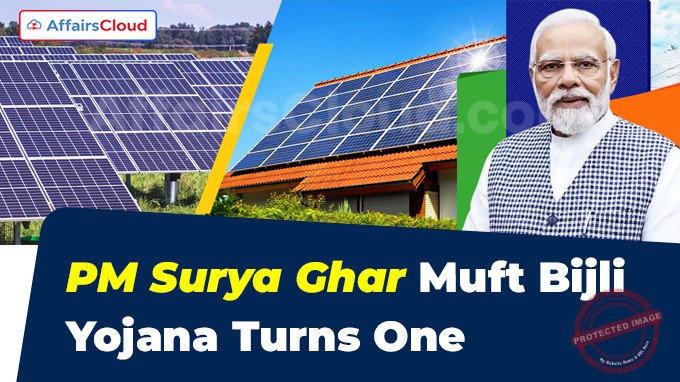 On February 13 2025, the Prime Minister Surya Ghar: Muft Bijli Yojana (PMSGMBY), the world’s largest domestic rooftop solar initiative marked its 1st anniversary, celebrating the year of empowering households with affordable solar energy and boosting India’s transition to a sustainable future.
On February 13 2025, the Prime Minister Surya Ghar: Muft Bijli Yojana (PMSGMBY), the world’s largest domestic rooftop solar initiative marked its 1st anniversary, celebrating the year of empowering households with affordable solar energy and boosting India’s transition to a sustainable future.
- The scheme was launched by Prime Minister (PM) Narendra Modi on February 13, 2024. It is being implemented by the Ministry of New and Renewable Energy (MNRE).
About PM-Surya Ghar: Muft Bijli Yojana:
i.In February 2024, the Union Cabinet chaired by PM Narendra Modi approved the scheme, with budgetary allocation of Rs 75,021 crore and is to be implemented till Financial Year 2026-27 (FY27).
ii.The scheme aims to provide free electricity of 300 units per month to 1 crore households in India by March 2027.
- As of January 2025, the scheme has already benefited 8.46 lakh households through rooftop solar installations.
- The rooftop solar installations will be implemented in a phased manner, expected to cross 10 lakh by March 2025, 20 lakh by October 2025, and reach 40 lakh by March 2026.
iii.The scheme is being implemented by the National Programme Implementation Agency (NPIA) at the national level and by State Implementation Agencies (SIAs) at the state level, which also include power Distribution Companies (DISCOMs) or power/energy departments, depending on the State or Union Territory (UT).
iv.The scheme offers a subsidy of up to 40% which makes the Renewable Energy (RE) a viable option in terms of affordability and accessibility.
Key Features of Scheme:
i.Subsidy based on Average Monthly Electricity Consumption: The subsidy provided under the scheme differs based on the average monthly electricity consumption of household and the corresponding suitable rooftop solar plant capacity:
- For average monthly electricity consumption of households between 0-150 units, with 1-2 kilowatt, (kW) rooftop solar plant capacity: the scheme will provide subsidy of Rs 30,000 to Rs 60,000.
- For average monthly electricity consumption of households between 150-300 units, with 2-3 kW rooftop solar plant capacity: The scheme will provide subsidy of Rs 60,000 to Rs 78,000.
- For average monthly electricity consumption of households more than 300 units, above 3kW rooftop solar plant capacity: The scheme will provide subsidy of Rs 78,000.
ii.Collateral-Free Loans: It also facilitates access to collateral-free, low-interest loans at around 7% interest for the installation of Residential rooftop solar (RTS) systems up to 3 kW capacity.
- The scheme offers a Central Financial Assistance (CFA) in the form of subsidy i.e. 60% subsidy for solar rooftop systems up to 2kW capacity.
- While, it offers a CFA of 40% for solar rooftop systems between 2kW to 3kW capacity.
- The CFA is capped for systems with a maximum capacity of 3 kW.
iii.Eligibility Criteria: It is mandatory that household to be an Indian citizen; The household is required to have a valid electricity connection; the household must not have availed the benefits of any other subsidy scheme for solar panels.
Key Progress:
i.Since the inception of scheme, the adoption of solar energy in India witnessed a ten-fold increase in monthly installation rates, which now stand at around 70,000 installations per month.
ii.So far, the Government of India (GoI) has disbursed Rs 4,308.66 crore as CFA to 5.54 lakh residential consumers, with average subsidy of Rs 77,800 per household.
iii.Also, an estimated 45% of the eligible beneficiaries are now receiving zero electricity bills, depending on their solar power generation and consumption.
iv.As of January 2025, Gujarat topped among all states in terms of highest number households benefited from the scheme, accounted 41.47% of the total number of households, followed by Maharashtra (22.79%), Uttar Pradesh (UP) (8.69%), Kerala (7.73%), and Rajasthan (3.14%).
Key Benefits:
i.Free Electricity for Households: The scheme provides subsidy on the installation of rooftop solar panels, thus benefiting households with free electricity and reducing their energy costs.
ii.Reduced Electricity Costs for the Government: The scheme will help the government in saving Rs 75,000 crore annually in electricity costs.
iii.Increased use of RE: The scheme promotes the adoption of RE sources, contributing to a more sustainable and eco-friendly energy mix in India.
iv.Reduced Carbon Emissions: The transition from fossil-based energy sources to solar energy under this scheme will help to lower carbon emissions, reaffirming India’s commitment to reducing its carbon footprint.
Impact of the Scheme:
i.Expansion of Solar Capacity: The scheme is estimated to add 30 Giga Watt (GW) of solar capacity through rooftop installations in the residential sector.
ii.Environmental Benefits: These rooftop solar systems have a lifetime of over 25 years, it is projected that the scheme will generate 1,000 Billion Units (BUs) of electricity while reducing Carbon dioxide (CO2) emissions by 720 million tonnes.
iii.Generation of Job Opportunities: The scheme is estimated to generate nearly 17 lakh direct jobs across various sectors such as: manufacturing, logistics, supply chain, sales, among others.
iv.Households Savings and Income Generation: Households will benefit from savings on their electricity bills and will also enable them to earn extra income by selling surplus power generated by their rooftop solar systems to DISCOMs.
Model Solar Village:
In August 2024, the MNRE issued the operational guidelines for implementing the Model Solar village under the PMSGMBY.
- Under the scheme component, emphasis has been laid on establishing one model solar village per district across India in order to promote solar energy adoption and enable village communities to become self-reliant in energy needs.
Key Components of Scheme:
i.Budget Allocation: The MNRE has allocated Rs 800 crore for the implementation of the scheme, providing Rs 1 crore per selected Model Solar Village.
ii.Eligibility Criteria for Village: A village must be a revenue village with a population size above 5,000 (or 2,000 for special category states) in order to qualify as a ‘candidate village’.
iii.Selection Process: The villages are selected by assessing their overall distributed renewable energy (RE) capacity installed in 6 months after being identified by District Level Committee (DLC).
- There will be one winning village in each district of the State which has the highest RE capacity and will receive a CFA grant of Rs 1 crore.
iv.Implementing Agency: The scheme will be implemented by State or Union Territory (UT) Renewable Energy Development Agency (REDA) under the supervision of the DLC.
About Ministry of New and Renewable Energy (MNRE):
Union Minister – Pralhad Joshi(Dharwad, Karnataka)
Minister of State(MoS) – Shripad Naik(Constituency – North Goa, Goa)




